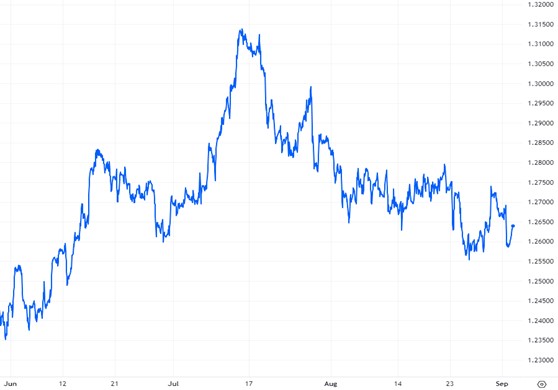GBP-USD Exchange Rate Languishes Throughout August
The pound slumped to a one-month low against the dollar at the start of August – setting the tone for a disappointing month for the GBP-USD pair. Its slide into the 1.26 range was triggered by news that the number of jobs created in the US increased by 324,000 through July – above forecasts of 189,000, indicating a robust US labour market.
But it was the Bank of England’s (BoE) dovish 25bps hike that dealt the UK currency the biggest blow. The central bank lifted rates to a fresh 15-year high of 5.25%, stoking fears that surging borrowing costs will hamper the UK’s economic growth.
The pound didn’t lick its wounds for long after BoE Governor Andrew Bailey left the door open for further hikes. Meanwhile, the dollar came under pressure after the latest ISM services PMI showed the key US services sector slowed more than expected in July – but remained in expansion territory.
The GBP-USD pair benefitted from more data-fuelled tailwinds following the release of underwhelming US jobs data, which signalled a cooling labour market and tempered rate hike bets from the Federal Reserve.
Having traversed the 1.27 range, the pair stumbled back below the benchmark on 8 August amid a souring market mood that stoked demand for the safe-haven dollar.
Risk appetite soon recovered in the wake of comments from Fed policymaker Patrick Harker who suggested US interest rates have peaked – helping the pound trim its losses.
Cooler-than-expected US inflation also weighed on the dollar. July’s CPI data showed headline inflation hit 3.2%, missing forecasts of 3.3% – causing the US currency to crater.
The GBP-USD pair continued its winning streak – briefly rising back above the 1.27 benchmark – following the release of GDP data for June, which revealed that the UK economy grew by more than expected.
A spell of relative calm followed for the pair, which gently meandered through the 1.26 range until Chinese economic headwinds prompted further global growth concerns, boosting safe-haven flows – and the dollar with it.
The dollar couldn’t cling onto the gains following the publication of the Fed’s latest meeting minutes, which struck a hawkish tone, with US policymakers appearing concerned about upside risks to inflation amid a tight labour market and a resilient economy.
Expectations of further policy tightening from the BoE gave the pound a shot in the arm, causing it to touch 1.2787 – its highest level in a week.
The UK’s latest consumer price index showed that headline inflation eased sharply in July from 7.9% to 6.8% and core inflation unexpectedly held steady at 6.9%, rather than dropping to 6.8%.
With wage growth rising to a record high and core inflation remaining persistently sticky, investors speculated that the BoE may opt to extend its rate hike cycle – an outlook that supported the pound.
Another sedate period for the pair ended abruptly when the pound surged to within touching distance of the 1.28 benchmark amid sticky core inflation – marking a one-month high against the dollar.
The UK currency toppled from its peak following the release of the latest UK private sector indexes, which showed the UK manufacturing and service sectors both weakened more than forecast in August, with the latter slipping into contractionary territory.
The pound picked itself up from the lower reaches of the 1.26 level and reclaimed some of its sharp losses following the release of private sector indexes on the other side of the pond. While less downbeat than the UK readings, both manufacturing and services slowed more than forecast, causing investors to take flight from the dollar.
During a turbulent period, the GBP-USD pair nosedived in the wake of hawkish Fed comments and strong initial jobless claims that boosted the dollar.
The number of Americans filing for unemployment unexpectedly fell to near six-month lows. The figures emphasised the US labour market’s historically tight levels and opened the door for the Fed to extend its policy tightening cycle.
Investors turned their attention to the annual economic policy conference in Jackson Hole, Wyoming. Bold comments from Fed officials propelled the dollar higher. Not least from Chairman Jerome Powell who said the economy hadn’t cooled as expected, remarking “there is no way to know what the neutral rate would be” – encouraging investors to bet on another hike in 2023.
The hawkish Fed rhetoric compounded fresh speculation from analysts that the BoE will pause recent interest rate rises after its September meeting, causing the pound to sink to 1.257 – its lowest level in 10 weeks.
The UK currency managed to gain some traction towards the end of the month as investors awaited comments by BoE Chief Economist Huw Pill for more direction on the central bank’s next move – which would cap a sluggish period for the GBP-USD pair which trended lower through August.
GBPUSD- 3 Month to Date

Looking ahead
The BoE announces its next interest rate decision on 21 September, with the central bank expected to raise by a quarter of a percentage point next month, taking rates from 5.25% to 5.5% – where they could peak.
Influential data from the UK economy in September: BoE Monetary Policy Report Hearings (7 September), ILO Unemployment Rate (12 September), Retail Sales (15 September), Consumer Price Index (20 September), S&P Global/CIPS Composite PMI (22 September), GDP (29 September).
The Fed announces its next interest rate decision on 20 September, with the central bank expected to raise rates then or at the following meeting in November.
Influential data from the US economy in September: Average Hourly Earnings (1 September), Nonfarm Payrolls (1 September), ISM Manufacturing PMI (1 September), ISM Services PMI (4 September), Consumer Price Index (13 September), Producer Price Index (14 September), Retail Sales (14 September), Michigan Consumer Sentiment Index (15 September), S&P Global/CIPS Composite PMI (22 September), GDP (28 September).






